 An invasive surgery can be a matter of concentration and complexity for a doctor. And the patient too finds it pathetic at times. But who thought that the robots would bring revolution in this field making surgeries more comfortable and easy going? That’s not a futuristic dream anymore. The invention of Robotic Surgery is a great aspect of technological advantages.
An invasive surgery can be a matter of concentration and complexity for a doctor. And the patient too finds it pathetic at times. But who thought that the robots would bring revolution in this field making surgeries more comfortable and easy going? That’s not a futuristic dream anymore. The invention of Robotic Surgery is a great aspect of technological advantages.
What is Robotic Surgery?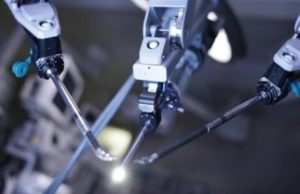
Robotic surgery or also referred as Robot-assisted surgery is a minimally surgery(that is the incisions made are tiny), wherein a camera arm and mechanical arms with surgical instruments are used. The surgeon controls the arms while seated at a computer console near the operating table. The console gives the surgeon a high-definition, magnified, 3-D view of the surgical site. These special surgical instruments are smaller, as well as more flexible and accurate than the human hands.The robot replicates the surgeon’s hand movements, while minimizing hand tremors. Robotic surgery turns out to be as an effective option for complex procedures. Moreover, it allows doctors to perform surgery with flexibility and more precision.
- Robotic surgery may be used for a number of different procedures, for example:-
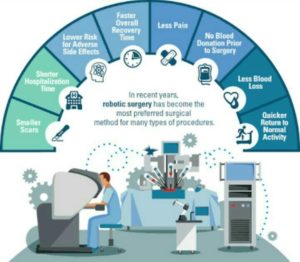
- Hip replacement
- Radical prostatectomy
- Radical cystectomy
- Kidney removal
- Kidney transplant
- Gallbladder removal
- Coronary artery bypass
- Pyloroplasty
Da Vinci surgery:-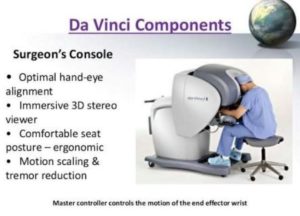
In the contemporary time, the da Vinci surgery is considered to be world’s most advanced robotic surgery. The da Vinci technology translates your surgeon’s hand movements into smaller, precise movements of tiny instruments inside your body. The System features a magnified 3D high-definition vision system and tiny wristed instruments that bend and rotate far greater than the human hand. The da Vinci System has brought minimally invasive surgery to more than 3 million patients worldwide.
Are you all fit for the robotic surgery?
Though this is a good option for your treatment, not always one will find that his or her health condition is appropriate to undergo a robotic surgery. It isn’t an option for everyone. So, the diagnosis is the most important part. Based on your health history, you are advised to proceed further for the surgery or to opt for another option. Consult your doctor even about the benefits and risks involved in the surgery. And compare it with other techniques, such as other types of minimally invasive surgery and conventional open surgery.
Getting ready for the treatment:-
- Do not any food or fluid for 8 hours before the surgery.
- Stop taking aspirin, blood thinners, anti-inflammatory medicines, vitamins, or other supplements 10 days before the procedure.
The procedure:-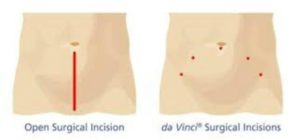
First of all the surgeon controls the instruments and cameras used in the surgery from a console located in the operating room. Placing his fingers into the master controls, he then operates all four arms of the da Vinci simultaneously while looking through a stereoscopic high-definition monitor. This gives him a better, more detailed 3-D view of the operating site than the human eye can provide. Every movement he makes with the master controls is replicated precisely by the robot. When necessary, the surgeon can even change the scale of the robot’s movements: If he selects a three-to-one scale, the tip of the robot’s arm will move just one inch for every three inches the surgeon’s hand moves. And because of the console’s design, the surgeon’s eyes and hands are always perfectly aligned with his view of the surgical site, minimizing surgeon fatigue.
The ultimate effect is to give the surgeon unprecedented control in a minimally invasive environment.
Recovery:-
Depending on the type of surgery performed, you may have to stay in the hospital overnight or for a couple of days. You should be able to walk within a day after the procedure. Avoid heavy lifting or straining until you are fully recovered. Do follow the instructions given by your doctor.
Pros:-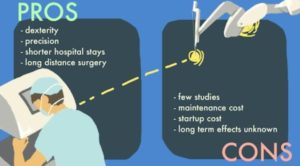
The list of pros the robotic surgery is a long one:-
- Precision
- Flexibility
- Faster Recovery
- Smaller scars
- Few infection
- Less pain and blood loss
- Reduced hospital stay
- Better cancer control
- Less damage to healthy tissue
- Reduction in the amount of personnel needed in the operating room during surgery.
- It can also provide a better work environment for the physician by reducing strain and fatigue.
- Surgeries that last for hours can cause even the best surgeons to experience hand fatigue and tremors, whereas robots are much steadier and smoother.
Risks
No doubt robotic surgery also involves risk and some of which may be similar to those of conventional open surgery. The most common risks are:-
- Extensive training time is required for physicians to learn to program and operate the machines.
- There are very few manufacturers of medical robotics. With very little competition, the few manufacturers that exist can set their own prices.
- Computer programs cannot change course during surgery, whereas a human surgeon can make needed adjustments.
Few of the types of robotic surgery:-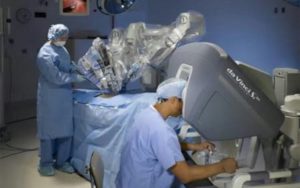
- Robotics in Spine Surgery:
The Renaissance Robotic Technology has been specifically designed for spine surgery. This transforms spine surgery from freehand procedures to highly-accurate, state-of-the-art robotic procedures, with less radiation.
- Robotics in colorectal surgery
Robotic surgery is now an extremely useful option in Colorectal surgery.
If medicine or lifestyle changes do not help a colorectal condition,the doctor may suggest surgery.
Surgery to remove all or part of the colon is known as a colectomy, and rectal cancer surgery to remove part or all or the rectum is known as a rectal resection. Minimally invasive surgery can be done using traditional laparoscopy or robotic-assisted da Vinci Surgery.
- Robotic cancer surgery
In cancer surgery, robotic techniques enable a radical operation to be performed with preservation of nerves and other critical structures, due to better visualisation. This is particularly important in rectal, gynaecologic and prostate cancer surgeries. For example, in robotic prostate cancer surgery, every effort is made to spare the nerves. The benefits are:-
- Precise removal of cancerous tissue
- Significantly reduced pain
- Less blood loss
- Less scarring
- Shorter hospital stay
- Faster return to normal daily activities
- Equivalent cancer cure rates as open surgery
- Better treatment for kidney, bladder and prostate cancer
- Transoral Robotic Surgery (TORS)
This is another type of minimally invasive surgery, specifically designed for patients with head and neck cancer. Here, the surgeon controls the robotic instruments that have been inserted through the mouth. No incisions are needed. In contrast, traditional open surgery requires long incisions through the throat and jaw, which often leave patients with visible scars, difficulty breathing or swallowing, and a lengthy recovery.
- Throat cancer
- Tongue cancer
- Tonsil cancer
- Undoubtedly, robotic surgical techniques have revolutionized cancer surgery and improved survival and quality of life in cancer patients, giving them real hope that cancer is conquerable.
- Robotic surgery in gynecology
The introduction of da Vinci robotic surgery to the field of gynecologic surgery has made minimally invasive procedures a possibility for a growing number of patients for whom open surgery was once the only option.
- Some Gynecological surgeries that are performed using Robotic technology are:
Hysterectomy, an operation to remove the uterus.
- A woman may have a hysterectomy for different reasons, including:
- Uterine fibroids that cause pain, bleeding, or other problems
- Abnormal vaginal bleeding
- Chronic pelvic pain
- Adenomyosis, or a thickening of the uterus
- Myomectomy, a surgical procedure to remove uterine fibroids.
- Robotic Urology:-
There are specific areas and disease processes in the human body that are very apt for robotic surgery. One of them is the pelvis (the lower part of the trunk between the abdomen and the thighs) and its organs (prostate, urinary bladder and uterus). Diseases of the kidneys, bladder, are all dealt with using robotic surgery.
The advantages have been extended to procedures requiring precision and accuracy like Partial Nephrectomy, which has enabled efficient nephron sparing surgery which results in kidney function preservation.
Robotic assisted Adrenalectomy, Pyeloplasty, Radical nephrectomy and Donor nephrectomy are being performed with increased frequency.
Robotic surgery is still a very new idea, and there is much more work to be done. But certainly, the future is going to be smooth and healthy with the emerging technologies.
